Genetics of the human Y chromosome and its association with male infertility
- PMID: 29454353
- PMCID: PMC5816366
- DOI: 10.1186/s12958-018-0330-5
Genetics of the human Y chromosome and its association with male infertility
Abstract
The human Y chromosome harbors genes that are responsible for testis development and also for initiation and maintenance of spermatogenesis in adulthood. The long arm of the Y chromosome (Yq) contains many ampliconic and palindromic sequences making it predisposed to self-recombination during spermatogenesis and hence susceptible to intra-chromosomal deletions. Such deletions lead to copy number variation in genes of the Y chromosome resulting in male infertility. Three common Yq deletions that recur in infertile males are termed as AZF (Azoospermia Factor) microdeletions viz. AZFa, AZFb and AZFc. As estimated from data of nearly 40,000 Y chromosomes, the global prevalence of Yq microdeletions is 7.5% in infertile males; however the European infertile men are less susceptible to Yq microdeletions, the highest prevalence is in Americans and East Asian infertile men. In addition, partial deletions of the AZFc locus have been associated with infertility but the effect seems to be ethnicity dependent. Analysis of > 17,000 Y chromosomes from fertile and infertile men has revealed an association of gr/gr deletion with male infertility in Caucasians and Mongolian men, while the b2/b3 deletion is associated with male infertility in African and Dravidian men. Clinically, the screening for Yq microdeletions would aid the clinician in determining the cause of male infertility and decide a rational management strategy for the patient. As these deletions are transmitted to 100% of male offspring born through assisted reproduction, testing of Yq deletions will allow the couples to make an informed choice regarding the perpetuation of male infertility in future generations. With the emerging data on association of Yq deletions with testicular cancers and neuropsychiatric conditions long term follow-up data is urgently needed for infertile men harboring Yq deletions. If found so, the information will change the current the perspective of androgenetics from infertility and might have broad implication in men health.
Keywords: AZF; AZFc; Infertility; Microdeletions; Prevalence; Spermatogenesis; Y chromosome; gr/gr deletions.
Conflict of interest statement
Authors’ information
DM is scientist E and Head of Molecular Biology, Indian Council of Medical Research, National Institute for Research in Reproductive Health, Mumbai, India. SC is a post-doctoral fellow, Indian Council of Medical Research, National Institute for Research in Reproductive Health, Mumbai, India.
Ethics approval and consent to participate
Not applicable as it is a review article.
Consent for publication
Not applicable.
Competing interests
The authors declare that they have no competing interests.
Publisher’s Note
Springer Nature remains neutral with regard to jurisdictional claims in published maps and institutional affiliations.
Figures
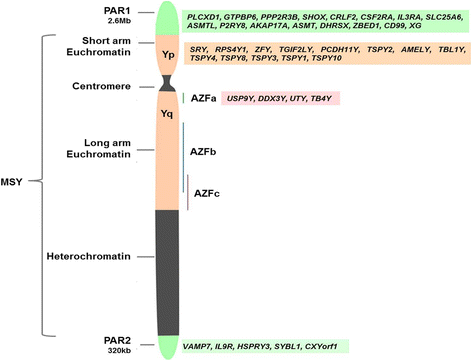
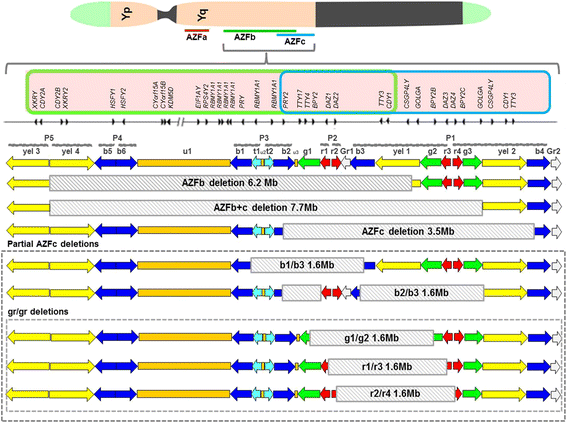

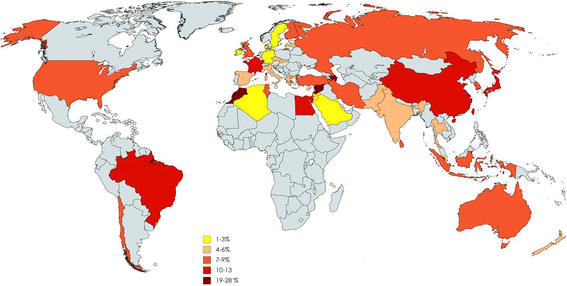
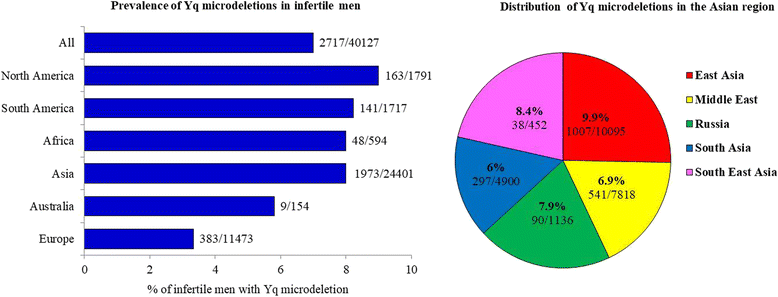
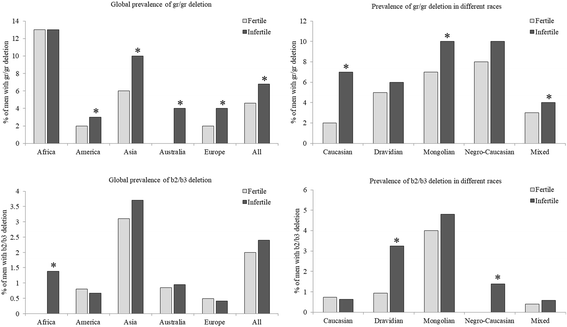
Similar articles
-
Chromosomal microarray analysis of infertile men with azoospermia factor microdeletions.Gene. 2020 Apr 20;735:144389. doi: 10.1016/j.gene.2020.144389. Epub 2020 Jan 23. Gene. 2020. PMID: 31982552
-
Detection of AZF microdeletions and reproductive hormonal profile analysis of infertile sudanese men pursuing assisted reproductive approaches.BMC Urol. 2021 Apr 23;21(1):69. doi: 10.1186/s12894-021-00834-3. BMC Urol. 2021. PMID: 33892694 Free PMC article.
-
Pseudoautosomal abnormalities in terminal AZFb+c deletions are associated with isochromosomes Yp and may lead to abnormal growth and neuropsychiatric function.Hum Reprod. 2017 Feb;32(2):465-475. doi: 10.1093/humrep/dew333. Epub 2017 Jan 5. Hum Reprod. 2017. PMID: 28057878
-
[Genetics and male infertility].Verh K Acad Geneeskd Belg. 2009;71(3):115-39. Verh K Acad Geneeskd Belg. 2009. PMID: 20088251 Review. Dutch.
-
Consequences of Y chromosome microdeletions beyond male infertility.J Assist Reprod Genet. 2019 Jul;36(7):1329-1337. doi: 10.1007/s10815-019-01492-z. Epub 2019 Jun 18. J Assist Reprod Genet. 2019. PMID: 31214882 Free PMC article. Review.
Cited by
-
Disruption of the Uty epigenetic regulator locus in hematopoietic cells phenocopies the profibrotic attributes of Y chromosome loss in heart failure.Nat Cardiovasc Res. 2024 Mar;3(3):343-355. doi: 10.1038/s44161-024-00441-z. Epub 2024 Mar 8. Nat Cardiovasc Res. 2024. PMID: 39183958 Free PMC article.
-
Retrospective analysis of the sex chromosomal copy number variations in 186 fetuses using single nucleotide polymorphism arrays.Front Genet. 2022 Dec 1;13:997757. doi: 10.3389/fgene.2022.997757. eCollection 2022. Front Genet. 2022. PMID: 36531253 Free PMC article.
-
The Role of Number of Copies, Structure, Behavior and Copy Number Variations (CNV) of the Y Chromosome in Male Infertility.Genes (Basel). 2019 Dec 29;11(1):40. doi: 10.3390/genes11010040. Genes (Basel). 2019. PMID: 31905733 Free PMC article. Review.
-
Heat shock factor 5 establishes the male germ-line meiotic sex chromosome inactivation through regulation of Smarca4.Heliyon. 2023 Apr 21;9(5):e15194. doi: 10.1016/j.heliyon.2023.e15194. eCollection 2023 May. Heliyon. 2023. PMID: 37206036 Free PMC article.
-
Molecular basis of sex differences in cancer: Perspective from Asia.iScience. 2023 Jun 12;26(7):107101. doi: 10.1016/j.isci.2023.107101. eCollection 2023 Jul 21. iScience. 2023. PMID: 37404373 Free PMC article. Review.
References
-
- WHO . Laboratory manual for the examination and processing of human semen. 5. Geneva: World Health Organization; 2010.
-
- Hotaling J, Carrell DT. Clinical genetic testing for male factor infertility: current applications and future directions. Andrology. 2014;2:339–350. - PubMed
-
- Colaco S, Lakdawala A, Modi D. Role of Y chromosome microdeletions in the clinical evaluation of infertile males. MGM J Med Sci. 2017;4:79–88.
-
- Hughes JF, Page DC. The biology and evolution of mammalian Y chromosomes. Annu Rev Genet. 2015;49:507–527. - PubMed
Publication types
MeSH terms
LinkOut - more resources
Full Text Sources
Other Literature Sources
Medical
Research Materials

